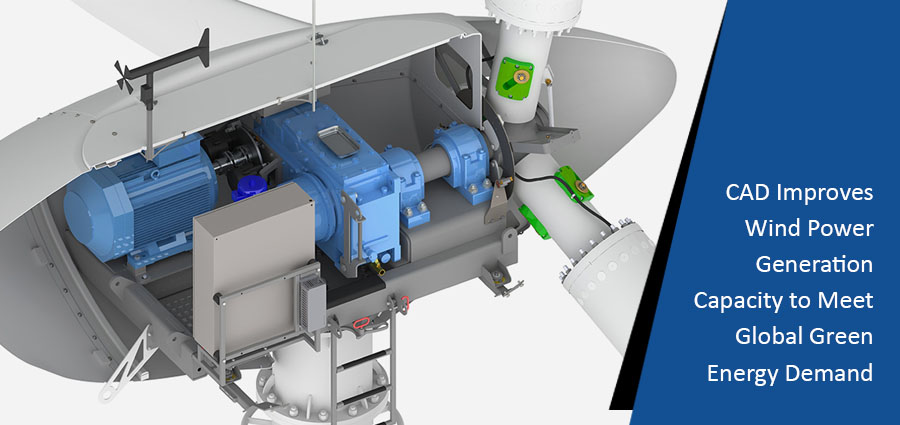
For technologically advanced nations, wind energy output targets grow higher with each passing year. Growing size of wind turbines and power generation capacity has obligated wind turbine manufacturers to deliver turbines of higher yield. But the question of how well the current designs of the wind turbines can scale in future is yet to be determined.
In such a scenario, CAD designs serve as a helping hand to the wind turbine design engineers and plant layout design engineers in increasing improvised output. CAD relieves design engineers from peer pressure by delivering wind turbines of higher yields.
Trending now in wind power generation industry
According to national Grid, UK had added a capacity of 975.1MW of wind energy and the power generation capacity increased by 2.5% during 2015. Germany too accrued wind power generation capacity of 44946.1MW of energy during that same year. TEIAS announced that Turkey too is set to add new wind power plants to generate extra capacity of 956MW of power.
How should wind turbine design engineers react to this boom?
Aero-foil wind turbine blades are in existence for years and several were designed even before pre-computer era. The need of the hour is to enhance existing designs by finding loop holes to yield required output. For altering existing wind turbine designs, engineering teams take help of CAD conversion processes to convert existing designs in editable CAD formats.
They do so because 3D CAD modeling geometry with solid modeling characteristics deals with higher level of complexity and warehouses PMI to avoid problems originating at the time of fabrication.
According to Douglas T. Ross, solving comes at later stages. The primary objective of design engineer working with CAD is not to resolve challenges, but to deliver and comprehensively state what the problem is.. With 3D CAD models, design problems become easier to detect, state, and perceive. 2D CAD drafting and 3D solid modeling helps in identifying design errors and changes required for replacing errors with novel engineering ideas.
CAD addresses two of the biggest hurdles in wind power generation
There are two major challenges that prevail in designing and setting up wind turbine plants as seen industry wide. Achieving the above cited statistics will necessarily require overcoming enlisted challenges:
- Increasing size of wind turbines and towers
- Optimum area utilization for plant set up
The turbine sizes may vary with changing markets and project sites; but the common trend of increment in size of the turbine tower and the rotor and blade dimensions cannot be negated. Today the average size of a tower turbine is about 80-85m [from sea level] with a rotor diameter of about 100 m. It is estimated that by the year 2030 world will see turbine towers as high as 115m Hub height and 135m of rotor diameter.
To address this continuous increase in size of wind turbines, testing of 3D CAD models have succeeded in opening new avenues for design options and validating them with virtual simulation. Howbeit; the initiation begins with a neat 2D drafts and designs, new designs with novel geometry are converted to 3D models, which are then sent for virtual simulation with the help of CFD.
Analysis software such as ANSYS develop insights for turbine design engineers to optimize blade dimensions considering various factors like angle between entry and exit tangent for wind striking the blade, drag and lift force etc.
Challenge ‘B’ is also swiftly dealt by with CAD software. 2D drawings of plant layout give insights to plant layout design engineer for optimally utilizing land resources. The layout when designed in one single 3D model is equipped to provide insights about efficiently designing and managing power loss during transmission. Efficient investment of resources is like a cherry on cake for plant design engineers.
Manufacturers see opportunities in CAD
Leading wind turbine manufacturers, before initiating the fabrication process, pay due diligence to design quality and virtual tests performed on wind turbine 3D CAD models. Besides when manufacturers are spending hundreds of dollars to manufacture just the blades with fiberglass material, they naturally won’t allow engineering change order in designs.
It is so because any change originating from fabrication shop floor due to under capacity, machine inability or any other reason, after the designs have been finalized and half way through the manufacturing, proves very costly. It is time these manufacturers have come to realization that fabrication drawings generated though CAD brings down engineering change orders and also assist for onsite and offsite assembly options.
Conclusion
The rising wind power generation needs of governmental authorities and expanding turbine sizes, manufacturers are expected to give accurate and efficient final products. CAD has come to rescue these manufacturers and wind turbine design engineers to swiftly accommodate innovations in designs, and embrace green energy on a full-fledged scale.





